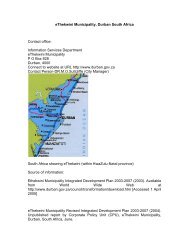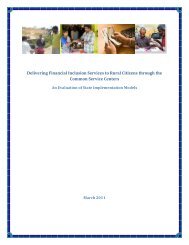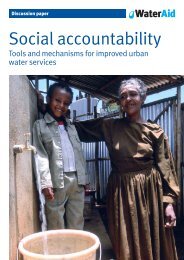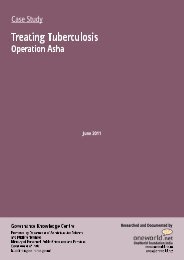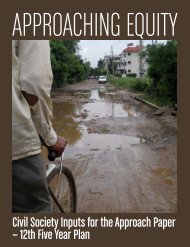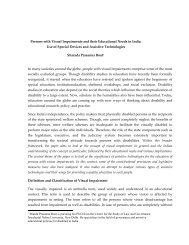Changing Framework of Local Governance and - Create
Changing Framework of Local Governance and - Create
Changing Framework of Local Governance and - Create
You also want an ePaper? Increase the reach of your titles
YUMPU automatically turns print PDFs into web optimized ePapers that Google loves.
<strong>Changing</strong> <strong>Framework</strong> <strong>of</strong> <strong>Local</strong> <strong>Governance</strong> <strong>and</strong> Community Participation in Elementary Educationwould be made an integral part <strong>of</strong> education at all levels. At the primary stage, suitableprogrammes were to be implemented to bring the school closer to the community with thefocus on serving the community in suitable ways (NCERT, 1971:22). It was argued that:School education is predominantly a local-state partnership <strong>and</strong> higher education is aCenter-State partnership. It is this basic principle that should guide the evolution <strong>of</strong>delicate balance between centralization <strong>and</strong> decentralization which our planning needs’(NCERT, 1971:848).However, the early 1970s witnessed a reverse, leading to the large-scale nationalisation <strong>of</strong>schools, particularly at the primary stage in most parts <strong>of</strong> the country. With this, stategovernments became the main providers <strong>and</strong> managers <strong>of</strong> elementary education. It is withinthis context that the Block Education Offices came into existence. This paved the way for thedeconcentration 4 <strong>of</strong> power, though considerable authority continued to be vested at the districtlevel, in particular with regard to recruitment, posting <strong>and</strong> transfer <strong>of</strong> personnel.Interestingly, while deconcentration was pursued with respect to district level administration,decision-making became more centralised at the state level – to some extent leading to theerosion <strong>of</strong> authority at the district level. The state secretariat, which within the originalframework dealt only with policy matters leaving all operational matters to the Directorate <strong>of</strong>Public Instruction <strong>and</strong> its subordinate <strong>of</strong>fices at the district level, assumed greater levels <strong>of</strong>direct responsibility for running the system. This was particularly so with respect to teacherappointments <strong>and</strong> the location <strong>of</strong> new schools. This also brought in a new dimension to theissue: what was hitherto mainly an affair <strong>of</strong> the pr<strong>of</strong>essional administration came into theambit <strong>of</strong> political action. The attention <strong>of</strong> the leadership, therefore, naturally was focused onstreamlining the administration leaving behind the policy <strong>of</strong> establishing decentralisedgovernance under the panchayati raj framework.Again in the 1980s a revival <strong>of</strong> interest in panchayati raj was witnessed in some <strong>of</strong> the states.Significant developments took place in states like Karnataka, The state not only conductedelections <strong>of</strong> local bodies but also took initiatives for providing block grants <strong>and</strong> considerableautonomy to the local bodies in using the finances. This prompted many local bodies toallocate funds for educational development activities at the district <strong>and</strong> sub-district levels. Ofcourse, some <strong>of</strong> these got reversed with changes in political leadership in the state,demonstrating the vulnerability <strong>of</strong> such measures to political vicissitudes. Interestingly,Andhra Pradesh moved away from the national pattern <strong>of</strong> a three-tier local governance systemcomprising district, block <strong>and</strong> village level bodies. Instead the state adopted a two-tier system,by <strong>and</strong> large following the recommendations <strong>of</strong> the Ashoka Mehta Committee (GoI, 1978)with local bodies at the district <strong>and</strong> m<strong>and</strong>al (consisting <strong>of</strong> about thirty villages) levels.However, unlike Karnataka, the reforms in Andhra Pradesh did not include any major move todecentralize governance <strong>of</strong> education sector. West Bengal also took up the task <strong>of</strong>strengthening the three-tier system for local governance <strong>and</strong> linking education governance4 Deconcentration is defined as “One <strong>of</strong> administrative decentralization which redistributes decision-makingauthority <strong>and</strong> financial <strong>and</strong> management responsibility among levels <strong>of</strong> the central government there is no realtransfer <strong>of</strong> authority between levels <strong>of</strong> government. It may involve only a shift <strong>of</strong> responsibilities from federalforest service <strong>of</strong>ficials <strong>of</strong> the capital city to those stationed in provinces, districts, etc” (Gregersen et al. 2004)As Govinda (1997:16) has pointed out “An obvious implication <strong>of</strong> this process is to move the administrative setup nearer to action setting, but by increasing the weight <strong>of</strong> bureaucracy”.4




